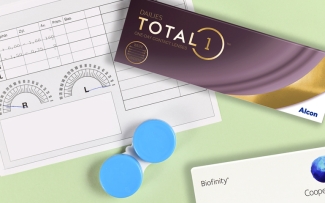What is base curve and diameter on contact lenses?
Every type of contact lens, no matter the style or brand, will have measurements that dictate the size and shape of the lens. These are called base curve and diameter. On your prescription or lens packaging, the base curve is often labelled BC or BOZR (base optic zone radius), and the diameter is usually displayed as DIA. These measurements are essential to ensure your contact lens fits snugly on your eye and allows for a comfortable wearing experience.
How to find your contact lens base curve & diameter
Base curve - labelled on lens packaging as BC alongside the base curve value.
Diameter - labelled on lens packaging as DIA alongside the diameter value.

What does the base curve number mean?
A base curve is a numbered measurement that represents how curved your contact lens is. This important number, typically between 8.3 and 9 millimetres in soft contact lenses, calculates how a contact lens will sit on the curvature of your eye’s surface. If this value is not appropriate for your cornea, even modest changes can result in discomfort and poor vision.
The larger the base curve number, the flatter the lens is. That means a person with a less curved cornea would wear a contact lens with a higher base curve number; someone with a more curved shaped cornea would need a ‘steeper’ base curve that has a lower number.
What does the diameter number mean?
The same as in geometry, the diameter is the length of one edge of the contact lens to the other. It is measured in millimetres and usually ranges between 13.80 and 14.50 mm, with 14.00 & 14.20 mm being the most common on commercially sold soft contact lenses. Effectively the size of the contact lens – the lens diameter is crucial because it ensures that it is not too loose or tight and covers the right area of your eye.
Which base curve or diameter should I choose?
Our in-house lead Optometrist, Roshni Patel, recommends that you only order the exact prescription prescribed to you by your eye care professional. Even a fractional difference in the base curve or diameter measurements can affect how the contact lens sits on your eye. If you end up wearing an incorrectly fitting contact lens, it may potentially harm the health of your eye and cause blurred vision. Luckily, most popular contact lens types are only manufactured in limited base curve and diameter options, so there is a smaller margin of error when entering your prescription details.
Everyone’s eyes are different, so what’s suitable for one person may not be suited for someone else. If you’re unhappy with the comfort of your lenses, we strongly advise speaking to your optician about trialling a new lens type.
Can I buy lenses with different base curves?
When purchasing contact lenses, the base curve values for your lenses should always match. In exceptional circumstances, an optician might advise a different base curve size for each eye, but this is relatively uncommon. When shopping with Lenstore, we’ll even alert you if you’ve entered a prescription with mismatched base curves to double-check that your lens details are correct.
Can I buy lenses with different diameters?
Most lenses are designed with a pre-set diameter to limit the number of lens variations the manufacturer needs to make. The diameter value will often be prefilled when entering your prescription, making it not possible to choose lenses with different diameters. One of the rare instances where you might wear lenses with different diameters is if your optician specifically prescribes a different lens type/brand for each eye.
Do I need the same base curve if I change lenses?
If you’re considering changing your lens type (e.g., from a clear to a coloured contact lens), you should have a contact lens fitting with your eye care professional first. They will make sure that the new base curve is the right fit for you, even if all the other details on your prescription match those of the new lens.
There are several factors that your optician will take into consideration and discuss with you before deciding whether a contact lens is suitable for you. Your contact lens material, wearing schedules, and contact lens care may all factor into this.
For example, coloured contact lenses typically have a fixed aperture that you see through – this measurement is not the same as the base curve. Your vision will be blurry if it is larger or smaller than your pupil size. Your optician will check that the contact lens is suitable for you in terms of the base curve and aperture before prescribing the lens.



